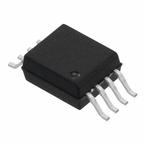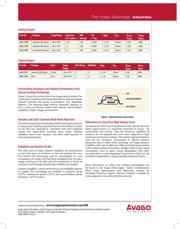herunterladen

The Avago Advantage
Technical Notes
Your Imagination, Our Innovation
Sense
•
Illuminate
•
Connect
Introduction
Isolation ampli ers are used to sense and isolate voltages
and are typically used to measure phase currents (with shunt
resistors) or DC-link voltages in three phase frequency converter
power applications as shown in Figure 1.
The maximum current is limited by the input voltage range
and power dissipation in the shunt resistor. With 200mV
input voltage range, currents of 150A are easily implemented.
However, if state of the art shunt resistors and thermal
management is applied, currents of 500A are within reach. The
bandwidth/response time is in the range of 1.6μs for analog
parts and 20MHz for sigma-delta outputs which is fast enough
for fault detection and protection in most applications.
Sigma Delta Technology
Isolation ampli ers encode the analog input signals using sigma-
delta technology before transmitting the information across
the insulation barrier, see Figure 2. The digital transmission
makes the solution immune to changes in LED light output
over temperature. In addition, sigma-delta encoding reduces
the overall sensitivity to noise and EMI commonly found in
industrial and power conversion equipment and environments.
Designers can use the isolated sigma delta output directly
from the isolation ampli er and decode the data stream
using digital lters in an FPGA or ASIC. The bene t, compared
to for example an SPI serial interface, is that the sigma-delta
output is not sensitive to lost bits caused by noise or EMI. A
designer also has the option to use isolation ampli ers with
analog outputs. Avago o ers state-of-the-art iso-amps with
both di erential and single-ended outputs with bandwidths
up to 200 kHz.
Highly accurate and safely isolated
current voltage sensing using Avago
isolation ampli ers
Current
Sense
Field Bus Communication
R
S
T
Voltage
Detection
Voltage
Sense
Brake
ACPL-C79B/C79A/C790
M
ACPL-C79B/C79A/C790
ACPL-C79B/C79A/C790
ASIC/MCU
Voltage
Regulator
Clock
Generator
Σ-Δ
Modulator
Input Encoder
LED Drive
Circuit
Detector
Circuit
MODULATOR OUTPUT
+FS (ANALOG INPUT)
–FS (ANALOG INPUT)
TIME
ANALOG INPUT
0 V (ANALOG INPUT)
Figure 1. Voltage and current sensing in a 3-phase motor drive application
Figure 2. Sigma-Delta (Σ-∆) analog to digital conversion
Accuracy
Accuracy can be divided into gain accuracy, o set error and
non-linearity. In general, isolation ampli ers have very low
drift over temperature but a certain tolerance on gain accuracy
before calibration. For systems where a calibration takes place
in the production line, the temperature drift speci cation
is usually the more relevant parameter. With the new ACPL-
C79B isolation ampli er, featuring 0.5% gain accuracy, a
designer can achieve excellent solution accuracy even
without calibration.




